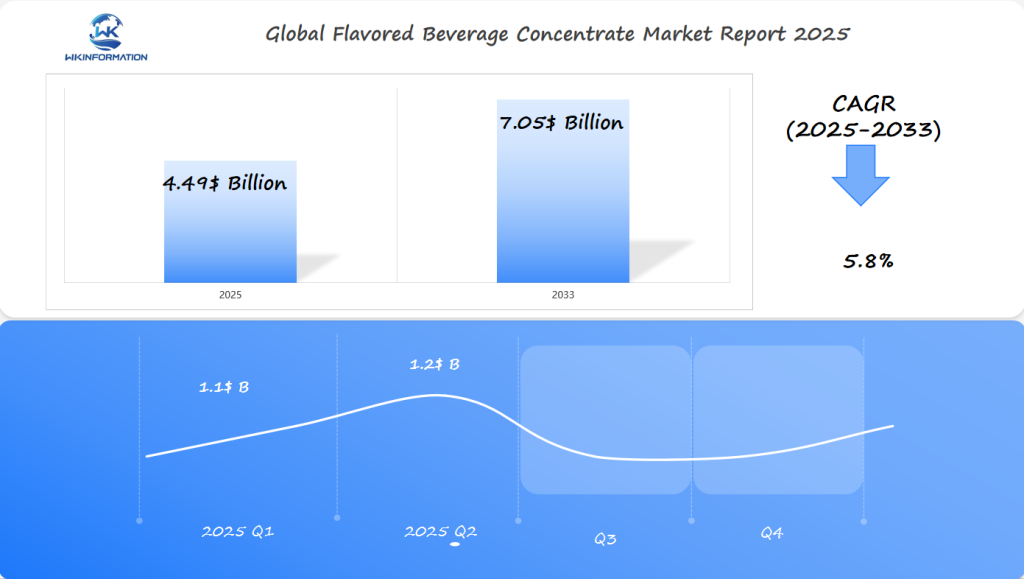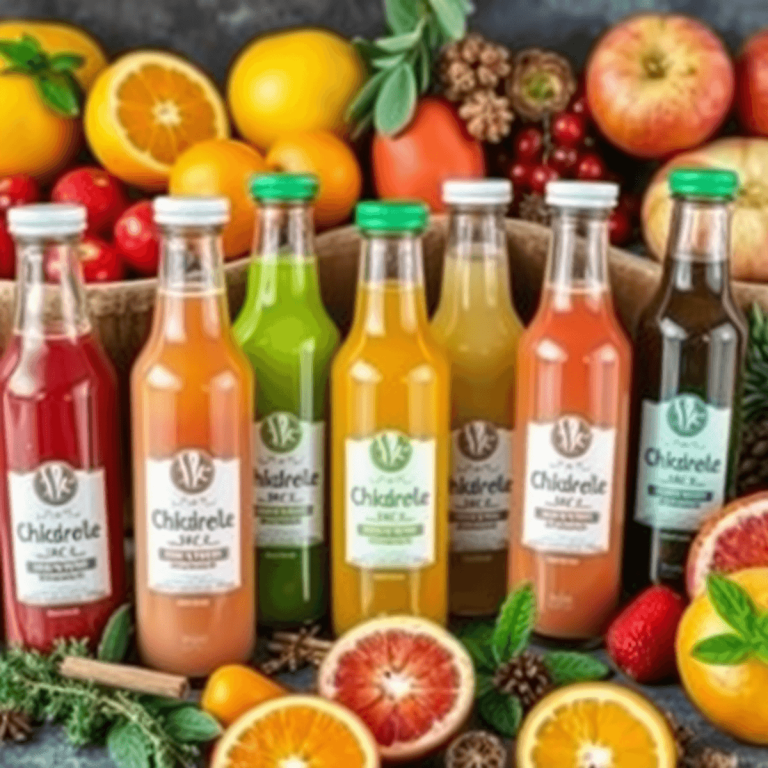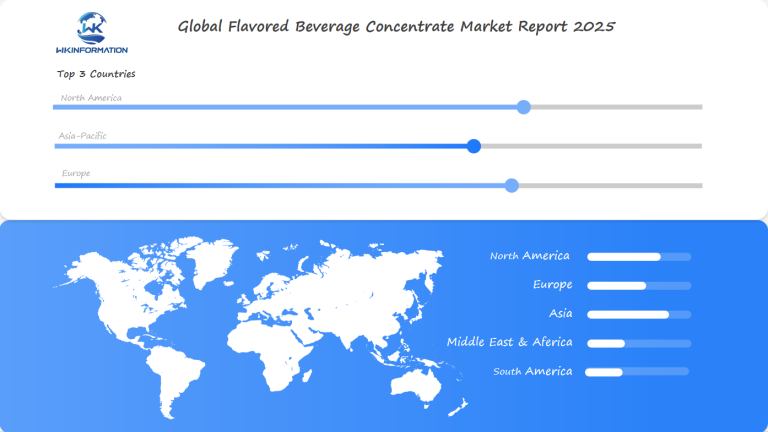2025 Flavored Beverage Concentrate Market Growth: USA, Mexico, and China Leading the Charge Worth $4.49 Billion
The flavored beverage concentrate market was valued at approximately USD 4.49 billion, demonstrating a strong presence. This upward trajectory is expected to persist, with projections forecasting a compound annual growth rate (CAGR) of 5.8% from 2025 to 2033. As a result, the market is anticipated to reach USD 7.05 billion by 2033.
- Last Updated:
Projected Market Insights for Flavored Beverage Concentrate in Q1 and Q2 of 2025
The Flavored Beverage Concentrate market is expected to reach a size of $4.49 billion in 2025, growing at a CAGR of 5.8% from 2025 to 2033. In Q1 of 2025, the market is projected to hit approximately $1.1 billion, driven by rising consumer demand for convenient, flavorful beverage options across various regions. By Q2, the market is expected to expand to around $1.2 billion, reflecting continued growth.
The USA, Mexico, and China will be the key countries to watch in this sector, with strong market performance anticipated due to their large consumer bases and increasing interest in ready-to-drink beverages. Rising health-consciousness, coupled with innovative product offerings, will further fuel growth in these markets, offering significant opportunities for market expansion.

Understanding the Supply Chain: Upstream and Downstream Factors in the Flavored Beverage Concentrate Market
To understand the flavored beverage concentrate market, it’s essential to know how the supply chain works. There are two main factors to consider: upstream and downstream.
Upstream Factors: Raw Materials and Production Efficiency
Upstream factors are mainly concerned with how companies source their raw materials and how efficient their production processes are. The quality and availability of key ingredients such as sugar, natural flavors, and sweeteners have a significant impact on production costs and timelines. To improve efficiency and increase output, companies are constantly optimizing their production methods by incorporating automation technologies.
Downstream Factors: Consumer Demand and Preferences
Downstream factors focus on consumer demand, which is influenced by buying behaviors and preferences. As more people become health-conscious, there is a growing trend towards products that contain natural ingredients and offer sugar-free options. This shift in consumer preferences drives manufacturers to innovate and create new products that align with these changing demands.
The Interplay Between Upstream and Downstream Factors
Both upstream and downstream factors are crucial in determining the growth of the flavored beverage concentrate market. Challenges faced in the upstream supply chain can affect stability, while downstream consumer preferences dictate market trends. This dynamic relationship pushes companies to continuously innovate in order to meet consumer expectations.
By understanding these upstream and downstream factors, industry players can navigate potential obstacles and seize new opportunities in the flavored beverage concentrate market.
Major Trends in the Flavored Beverage Concentrate Market for 2025
1. Shift Towards Organic Ingredients
An increasing shift towards organic ingredients is reshaping product innovation within the flavored beverage concentrate market. Consumers are becoming more health-conscious, driving demand for beverages that prioritize natural and organic components over artificial additives.
2. Rise of Sugar-Free Products
The preference for sugar-free products is another significant trend gaining momentum. Health-conscious consumers are actively seeking alternatives to traditional sugary beverages, pushing brands to innovate with sugar-free options that do not compromise on taste. This shift aligns with broader health trends and regulatory pressures to reduce sugar consumption.
3. Impact of Automation Technology
Automation technology is transforming production processes across the industry. Enhanced automation allows manufacturers to improve production efficiency, scale operations, and meet the rising demand effectively. As consumer preferences continue to evolve, automation becomes a vital tool for maintaining competitiveness in a rapidly changing market landscape. This transformation is part of a broader trend towards advanced food and beverage processing technology, which includes the integration of automation in production methods.
These trends signify a dynamic shift towards healthier, more efficient beverage solutions, reflecting changing consumer values and technological advancements in production methods.
Challenges and Restrictions Impacting the Flavored Beverage Concentrate Market
Navigating the flavored beverage concentrate market requires overcoming various regulatory challenges. Manufacturers face stringent regulations varying across regions, which often affect product formulation, labeling, and distribution. Compliance with diverse regulatory standards can increase production costs and delay market entry.
Supply chain disruptions post-pandemic have further complicated market dynamics. The pandemic exposed vulnerabilities in global supply chains, leading to raw material shortages and increased transportation costs. These disruptions hinder timely production and delivery, impacting market growth.
Competition within the industry is fierce, with numerous players vying for market share. Established companies like International Flavors & Fragrances Inc., Kerry Group plc., and Golden State Foods dominate, making it challenging for new entrants to gain a foothold. This competitive landscape necessitates innovation and strategic partnerships for survival and growth.
Understanding these challenges provides insights into potential risks and opportunities within the flavored beverage concentrate sector. Addressing regulatory hurdles, stabilizing supply chains, and innovating amidst competition are crucial steps for industry players aiming to succeed in this evolving market environment. One segment that has shown promise amidst these challenges is the lime juice concentrate market, which may provide valuable lessons and opportunities for growth in the broader flavored beverage concentrate sector.

Geopolitical Impact on the Flavored Beverage Concentrate Industry
Geopolitical tensions have a significant impact on trade policies related to beverage concentrates, influencing everything from tariffs to import/export regulations. These tensions can lead to changes in supply chain dynamics, affecting how easily companies can access international markets. For instance, disagreements between major trading nations could result in increased tariffs or stricter import restrictions, making it more challenging for manufacturers to maintain competitive pricing.
Implications for North America and Asia-Pacific
In regions like North America and Asia-Pacific, the implications for market stability are profound.
North America
North America, with its strong consumer base and established manufacturing sectors, may face disruptions if trade relations with key partners become strained. This could lead to fluctuations in market prices and availability of raw materials.
Asia-Pacific
Asia-Pacific, particularly China, is rapidly emerging as a key player in the flavored beverage concentrate market. However, geopolitical instability within this region can disrupt growth trajectories by affecting investor confidence and altering the regulatory landscape.
Key Considerations:
- Trade Policies: Changes due to international relations affect cost structures and market access.
- Market Stability: Both North America and Asia-Pacific face potential volatility depending on geopolitical climates.
Understanding these factors is crucial for stakeholders aiming to navigate the complex global landscape of flavored beverage concentrates.
Types of Flavored Beverage Concentrates and Their Innovations
Flavored beverage concentrates come in a variety of forms, each offering unique flavor profiles that cater to diverse consumer preferences. Among the most common types are:
- Syrups: These are versatile and commonly used for sweetening and flavoring beverages like sodas and cocktails. They offer concentrated flavors ranging from classic vanilla and cherry to exotic options like mango or passion fruit.
- Enhancers: Often used to add a burst of flavor to water or other beverages, enhancers are typically available in convenient squeeze bottles, allowing consumers to adjust the intensity of the flavor to their liking.
The ongoing discussion about natural vs synthetic flavors is reshaping this market. Natural flavors, derived from real fruits and plants, appeal to health-conscious consumers seeking cleaner labels. On the other hand, synthetic flavors offer consistency and longer shelf life at a lower cost.
Companies are leading the way in creating innovative flavoring solutions by using advanced technology and culinary expertise. These innovations include botanical infusions, which add a sophisticated layer of taste using herbs and spices, and customizable flavor experiences, where consumers can tailor flavors to their personal taste preferences through interactive digital platforms. Such innovations not only enhance consumer engagement but also drive market growth by continually refreshing product offerings.
Applications of Flavored Beverage Concentrates in Soft Drinks, Juices, and More
Flavored beverage concentrates are incredibly versatile and can be used in a wide range of beverages. They are the key ingredient in many products, improving the taste of soft drinks and juices with a wide variety of flavors.
Soft Drinks
Concentrates play a crucial role in creating both traditional and new soft drink flavors. They give manufacturers the opportunity to try out different combinations and appeal to various consumer tastes.
Juices
The use of concentrates in juices adds depth and richness, often infusing exotic notes that elevate traditional fruit juices. This versatility makes them indispensable in creating refreshing and unique juice blends.
Other uses include improving the taste of cocktails, sports drinks, and even non-alcoholic beverages, where they offer essential flavoring without relying on artificial additives. This flexibility highlights their importance in the flavored beverage concentrate market, meeting the changing needs for various and creative beverage formulations.
A Global Overview of the Flavored Beverage Concentrate Market: Regional Insights
The flavored beverage concentrate market has different dynamics in various parts of the world, influenced by consumer preferences and regulations.
North America
North America stands out with its strong emphasis on health consciousness, driving consumers towards healthier alternatives. This region benefits from aggressive marketing strategies and a well-established e-commerce infrastructure that broadens market reach. Regulations here are stringent, focusing on product safety and labeling, which encourages innovation in sugar-free and organic concentrates.
Asia-Pacific
In contrast, Asia-Pacific, particularly China, is witnessing rapid growth fueled by an expanding middle class with evolving tastes. The demand for convenience beverages aligns with the broader trend towards urbanization. Regulatory frameworks in this region are becoming progressively supportive of new entrants, facilitating market expansion.
These regional insights highlight global market trends where diverse consumer behaviors and regulatory environments play pivotal roles in shaping the flavored beverage concentrate landscape. These factors set the stage for varied growth trajectories across different markets.

USA Flavored Beverage Concentrate Market: Growth Drivers and Opportunities for Innovation
North America trends are heavily influenced by health-conscious consumers seeking alternatives to sugary beverages. The shift towards healthier lifestyles is a crucial factor driving growth in the US flavored beverage concentrate market.
Key Factors Driving Growth
- Health Consciousness: There’s an increasing demand for products with reduced sugar content, natural ingredients, and organic certifications. This demand encourages companies to innovate, focusing on sugar-free and low-calorie options.
- Innovation Opportunities: The market is ripe for innovation in flavor profiles and product formulations. Companies are exploring unique flavor combinations that cater to diverse consumer tastes while leveraging novel ingredients like adaptogens and botanicals.
- Technological Advancements: Utilization of automation technology in production processes enhances efficiency and meets growing demand. This includes implementing advanced manufacturing techniques to ensure consistency and quality in flavored concentrates.
The US market presents a promising landscape for brands willing to adapt to these evolving consumer preferences and leverage technological advancements.
Mexico's Unique Flavor Journey - Trends Shaping The Mexican Market For 2025
The Mexican market for flavored beverage concentrates is experiencing an exciting transformation, heavily influenced by its vibrant cultural heritage. Mexican market trends are being shaped by a strong inclination towards traditional flavors that reflect the country’s diverse culinary traditions.
1. Cultural Influences
Mexican consumers are showing a growing preference for flavors inspired by local ingredients such as tamarind, hibiscus, and lime. These flavors not only resonate with traditional tastes but also bring a sense of nostalgia and authenticity to modern beverage offerings.
2. Health Consciousness
There’s an increasing demand for healthier options that cater to the rising awareness of wellness. This trend is driving the market towards sugar-free alternatives and natural flavoring solutions, aligning with global health trends while maintaining a distinct regional touch.
3. Innovation in Products
Companies are exploring innovative flavor combinations that appeal to both local tastes and international palates. This innovation is crucial in expanding the reach of Mexican flavors beyond its borders, contributing to the global growth of the flavored beverage concentrate market.
Mexican consumers’ deep connection to their culinary roots combined with a modern twist on health and innovation makes this market uniquely poised for significant growth by 2025.
China’s Rapid Rise - A Look At Emerging Trends In The Chinese Market
China’s flavored beverage concentrate market is growing rapidly. Several factors contribute to this trend:
1. Rising Middle-Class Demands
With an expanding middle class, there’s a heightened demand for premium and diverse beverage options. This group seeks quality and variety, driving the need for innovative flavored concentrates.
2. E-commerce Expansion
The growth of e-commerce platforms in China makes it easier for consumers to access a wide range of flavored beverages. They can conveniently explore and purchase products from both local and international brands.
3. Health-Conscious Shifts
As people become more aware of health issues, there is an increasing interest in sugar-free and natural ingredient-based concentrates. Products that meet these preferences are experiencing significant growth.
Predictions suggest that consumer preferences will continue to evolve, favoring unique flavors and healthier options. Therefore, companies looking to gain market share in China must prioritize innovation and adapt to these changing consumer demands.
What’s Next? Future Outlook For The Entire Industry By 2025
The future of the flavored beverage concentrate market looks promising, with expected changes in consumer preferences driving businesses to adapt quickly. Here are some key trends to watch out for:
1. Health-conscious Choices
Consumers are expected to demand more sugar-free and natural flavor options, leading to a rise in innovative product development focusing on wellness.
2. Sustainability Practices
A growing emphasis on sustainable sourcing and eco-friendly packaging could redefine production practices and brand positioning within this sector.
3. Technological Integration
Automation and digitalization will likely play crucial roles in improving efficiency and meeting increasing demands.
These anticipated changes present significant opportunities for businesses looking to succeed in the evolving flavored beverage concentrate market by 2025. By embracing these trends, companies can not only meet consumer expectations but also gain a competitive edge through innovation and sustainability.
Competitive Overview of the Flavored Beverage Concentrate Market
Key Players:
1. PepsiCo Inc. —— United States
2. The Coca-Cola Company —— United States
3. Cott Corporation —— Canada
4. Dohler GmbH —— Germany
5. The Kraft Heinz Company —— United States
6. Dr. Pepper Snapple Group Incorporated —— United States
7. Monster Beverage Corporation —— United States
8. Nestlé SA —— Switzerland
9. Ingredion Incorporated —— Unite
Overall
| Report Metric | Details |
|---|---|
| Report Name | Global Flavored Beverage Concentrate Market Report |
| Base Year | 2024 |
| Segment by Type |
|
| Segment by Application |
|
| Geographies Covered |
|
| Forecast units | USD million in value |
| Report coverage | Revenue and volume forecast, company share, competitive landscape, growth factors and trends |
The flavored beverage concentrate market presents a dynamic landscape, as highlighted in this comprehensive analysis. The market’s growth trajectory remains promising, driven by consumer demand for innovative and healthier flavored options. Key players like The Coca-Cola Company and PepsiCo, Inc. continue to shape the market dynamics through strategic partnerships and product innovation. Future projections indicate significant opportunities in emerging markets, where companies can capitalize on evolving consumer preferences. This assessment underscores the market’s potential, offering stakeholders a robust opportunity to explore new avenues and enhance their market presence.
Global Flavored Beverage Concentrate Market Report (Can Read by Free sample) – Table of Contents
Chapter 1: Flavored Beverage Concentrate Market Analysis Overview
- Competitive Forces Analysis (Porter’s Five Forces)
- Strategic Growth Assessment (Ansoff Matrix)
- Industry Value Chain Insights
- Regional Trends and Key Market Drivers
- Flavored Beverage Concentrate MarketSegmentation Overview
Chapter 2: Competitive Landscape
- Global Flavored Beverage Concentrateplayers and Regional Insights
- Key Players and Market Share Analysis
- Sales Trends of Leading Companies
- Year-on-Year Performance Insights
- Competitive Strategies and Market Positioning
- Key Differentiators and Strategic Moves
Chapter 3: Flavored Beverage Concentrate Market Segmentation Analysis
- Key Data and Visual Insights
- Trends, Growth Rates, and Drivers
- Segment Dynamics and Insights
- Detailed Market Analysis by Segment
Chapter 4: Regional Market Performance
- Consumer Trends by Region
- Historical Data and Growth Forecasts
- Regional Growth Factors
- Economic, Demographic, and Technological Impacts
- Challenges and Opportunities in Key Regions
- Regional Trends and Market Shifts
- Key Cities and High-Demand Areas
Chapter 5: Flavored Beverage Concentrate Emerging and Untapped Markets
- Growth Potential in Secondary Regions
- Trends, Challenges, and Opportunities
Chapter 6: Product and Application Segmentation
- Product Types and Innovation Trends
- Application-Based Market Insights
Chapter 7: Flavored Beverage Concentrate Consumer Insights
- Demographics and Buying Behaviors
- Target Audience Profiles
Chapter 8: Key Findings and Recommendations
- Summary of Flavored Beverage Concentrate Market Insights
- Actionable Recommendations for Stakeholders

Access the study in MULTIPLEFORMATS
Didn’t find what you’re looking for?
TALK TO OUR ANALYST TEAM
Need something within your budget?
NO WORRIES! WE GOT YOU COVERED!
Call us on: +1-866-739-3133
Email: infor@wkinformation.com
What is the projected value of the flavored beverage concentrate market by 2025?
The flavored beverage concentrate market is projected to reach a value of $4.49 billion by 2025, with significant contributions from the USA, Mexico, and China.
What are the major trends influencing the flavored beverage concentrate market?
Key trends include the rise of organic and natural ingredients, increasing demand for sugar-free products among health-conscious consumers, and the adoption of automation technology to enhance production efficiency.
What challenges does the flavored beverage concentrate market currently face?
Manufacturers face regulatory challenges, supply chain disruptions post-pandemic, and intense competition which collectively impact market growth.
How do geopolitical factors affect the flavored beverage concentrate industry?
Geopolitical tensions can influence trade policies related to beverage concentrates, thereby affecting market stability in leading regions such as North America and Asia-Pacific.
What types of flavored beverage concentrates are available in the market?
The market offers various types of flavored concentrates including syrups and enhancers, each featuring unique flavor profiles. Innovations are emerging around natural versus synthetic flavors.
What applications do flavored beverage concentrates have in the beverage industry?
Flavored beverage concentrates are versatile and used across multiple applications including soft drinks, juices, and other beverages, allowing for diverse formulations tailored to consumer preferences.


